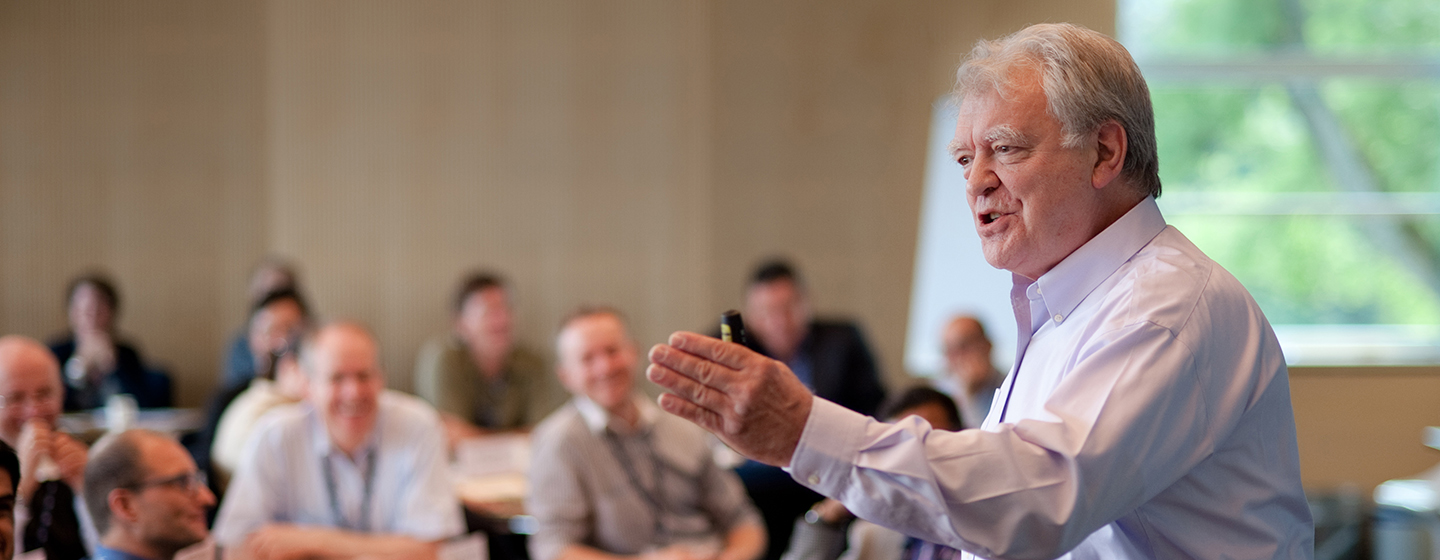Unlike the traditional case-study-driven approach of most business school programs, IMD’s High Performance Leadership program – celebrating its 25th anniversary this month – centers on a single, profound case: the participants themselves.
“It starts with a very powerful question: What has happened to you to become the leader you are?” explains George Kohlrieser, Program Director and Distinguished Professor of Leadership and Organizational Behavior, in a conversation with Associate Director Professor John Weeks.
Over six transformative days, participants explore the formative relationships of their past – with parents, siblings, teachers, and superiors – to uncover how these experiences have shaped their leadership behaviors today. “For many people, this is transformational because they are leading without knowing who they are as a leader,” says Kohlrieser.
Drawing on his experience as a hostage negotiator, Kohlrieser encourages participants to examine whether they are being held “psychologically hostage” by unresolved emotions – fear, anger, regret, grief – and events that happened or are still happening to them. They learn how to harness their ‘person effect’ – the power of their state of being, words, behavior, mindset, and physiology – to project a calm and grounded presence that fosters trust and inspires risk-taking among their teams.
Origins of the program
The program itself owes its existence to a bold and visionary act by Kohlrieser. In 2000, when then IMD President Peter Lorange asked him to contribute to a new advanced leadership course, where professors would each deliver half-day sessions, Kohlrieser hesitated. Unconvinced, he asked for a few days to propose an alternative idea. He came back with the concept of High Performance Leadership based on the red thread of emotional intelligence.
Shortly after, IMD launched the first program with 40 participants. Now, 24 years later, Kohlrieser has taught more than 10,000 executives during 152 editions of the program.
In the early days, Kohlrieser received pushback from some participants who were stuck in a mindset of “command and control” leadership. Focused on acquiring practical tools to get results over gaining deeper self-awareness so they could inspire and develop people, they’d say: ‘What do you mean by empathy, caring? I’m here to get a result,’ he recalls.
While listening with compassion, Kohlrieser’s goal was to help change their perspective. “Leadership is not a transaction. It’s a relationship. How do you have a relationship with your boss, your employees, with your clients, with those people you are serving?”
Over the years, the program has continually evolved, integrating new insights and practices. It now addresses the role of dialogue and relational inquiry in navigating difficult conversations. He draws on the ever-expanding body of research around trauma and embraces the concept of psychological safety – a term coined by Harvard Professor Amy Edmondson to describe a workplace culture where employees can speak up without fear of retribution.
Today, the program’s impact speaks for itself. Some 80% of participants attend on the recommendation of alumni, and the demand has grown so significantly that waiting lists often stretch up to a year.
‘Leadership is who you are as a person’
High Performance Leadership has profoundly transformed both the professional and personal lives of countless alumni over the years. However, there are a few stories that stand out vividly for Kohlrieser.
He recalls a participant from the Middle East who had grown up in an environment where emotions were never expressed. This lack of early bonding left him struggling to connect with his team as a leader. A pivotal moment came when he realized it was not only acceptable but essential to show care and vulnerability. That evening, he returned to his hotel and called each of his six daughters to tell them, for the first time, that he loved them. He not only changed personally; he also changed professionally by connecting with his teams in a very different way.
“Leadership is not something you do at work – it’s not like a shirt or dress you put on. It’s who you are as a person. That bridge between your personal and professional life is connected, and who you are as a person will affect how you are influencing others.” George Kohlrieser
Another memorable participant was a CFO, who had been promoted to CEO, and would take the back stairs to his office to avoid talking to people. Recognizing he was failing, the participant agreed during the program to enter through the front door and greet everyone on all six floors. He was very uncomfortable at first but with his coaching team’s support, he then learned to rewire his brain and enjoy the experience. “It changed the whole way he was leading. They suddenly saw him as a human being,” says Kohlrieser.
From hostage negotiator to leadership professor
Kohlrieser, who grew up on a farm in Ohio and was sent to a Catholic seminary aged 13, had a distinctive and varied career before coming to IMD. On leaving the seminary at age 22, he worked in a factory to pay his way through college. After becoming a licensed psychologist, he worked with the police department of Dayton, Ohio. Held hostage four times, he learned the power of words in creating a connection and understanding the pain points of others – techniques which he later brought into his leadership training. During his time as a hostage negotiator, he also hosted a call-in radio show called Matters of the Mind for 10 years.
When his oldest son died in a tragic accident, Kohlrieser decided to travel to bring the concept of transactional analysis – a form of psychotherapy that examines how we speak and respond to others through the roles that we play – to Europe. He first started teaching conflict management at IMD before moving into leadership.
“Hostage negotiation is leadership in action,” says Kohlrieser. “They get a 95% success rate not by telling people what to do, but by influencing. This has been one of the big game changers in leadership: Bringing hostage negotiation techniques from physical hostage situations to leaders who are psychological hostages – to others, situations, or even to themselves – enables profound transformation, allowing leaders to discover the full joy of leading and of life itself.”



